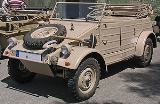
Volkswagen Kübelwagen
Encyclopedia
The Volkswagen Kübelwagen (short for Kübelsitzwagen, meaning "bucket seat
car") was a military vehicle designed by Ferdinand Porsche
and built by Volkswagen
during World War II
for use by the German
military (both Wehrmacht
and Waffen-SS
). Based heavily on the Volkswagen Beetle
, it was prototyped as the Type 62, but eventually became known internally as the Type 82.
With its rolling chassis and mechanics built at Stadt des KdF-Wagens
, (renamed Wolfsburg after 1945), and its body built by US-owned firm Ambi Budd
in Berlin http://www.ltv-vwc.org.uk/wheelspin/ws_july_2000/Wierd05_Military01.htm, the Kübelwagen was for the Germans what the jeep
was for the Allies
.
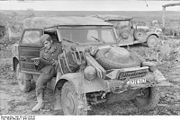
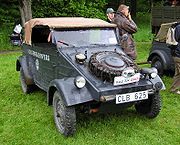
 Although Adolf Hitler
Although Adolf Hitler
discussed with Ferdinand Porsche
the possibility of military application of the Volkswagen as early as April 1934, it wasn't until January 1938, that high-ranking Third Reich army officials formally approached Porsche about designing an inexpensive, light-weight military transport vehicle that could be operated reliably both on- and off-road in even the most extreme conditions, suggesting that the Beetle could provide the basis for such a vehicle.
Porsche began work on the project immediately, having a prototype of the vehicle ready within the month, but realized during development that it wouldn't be enough to reinforce the Beetle's chassis to handle the stresses that military use would put on it. In order to guarantee adequate off-road performance of a two-wheel-drive vehicle with a 1,000 cc FMCV 1 engine, it would have to be lightweight. In fact, the army had stipulated a laden weight of 950 kg (2,094.4 lb) including four battle-dressed troops, which meant that the vehicle itself should not weigh more than 550 kg (1,212.5 lb). Porsche therefore sub-contracted Trutz, an experienced military coachbuilder to help out with the body design.
Developmental testing by the military began after a presentation of the prototypes designated as Type 62 in November 1938. Despite lacking four wheel drive
, a mainstay of the American
military Jeep
s, the vehicle proved very competent at maneuvering its way over rough terrain, even in a direct comparison with a contemporary standard German army 4x4, and the project was given the green light for further development. The vehicle's light weight and ZF self-locking differential compensated for the lack of 4X4 capabilities.
Further development of the Type 62 took place during 1939, including a more angular body design; and pre-production models were field-tested in the invasion of Poland that started in September that year. Despite their overall satisfaction with the vehicle's performance, military commanders demanded that a few important changes be made: the lowest speed of the vehicle had to be reduced from 8 km/h (5 mph) to 4 km/h (2.5 mph) as an adjustment to the pace of marching soldiers. Secondly it needed some improvement of its off road ability. Porsche responded to both requests by mounting new axles with gear-reduction hubs, providing the car with more torque and more ground-clearance all at once. Revised dampers, 41 cm (16.1 in) wheels and a limited slip differential, as well as countless small modifications completed the specification. In order to reflect the changes, the vehicle was re-named Type 82.
Full scale production of the Type 82 Kübelwagen started in February 1940, as soon as the VW factories had become operational. No major changes took place until production ended in 1945, only small modifications were implemented — mostly eliminating unnecessary parts and reinforcing some which had proved unequal to the task. Prototype versions were assembled with four-wheel-drive (Type 86) and different engines, but none offered a significant increase in performance or capability over the existing Type 82 and the designs were never implemented. As of March 1943, the car received a revised dash and the bigger 1,131 cc engine developed for the Schwimmwagen that produced more torque and power than the original 985 cc unit. When Volkswagen production ceased at the end of the war, 50,435 Kübelwagen vehicles had been produced http://mitglied.lycos.de/Geschichtsverein/vwik.html and the vehicle had proven itself to be surprisingly useful, reliable, and durable.
VW resurrected the basic Kübelwagen design several decades after the war as the 1969 Type 181
, developed for the German Federal Armed Forces
and later also produced for the civilian market known as "Thing" in the US, "Trekker" in the UK and "Safari" in Mexico. Although similar in looks and design, almost no parts were interchangeable with the Type 82.
In November 1943, the U.S. military conducted a series of tests as well on several Type 82s they had captured in North Africa
; they concluded that the vehicle was simpler, easier to manufacture and maintain, faster, and more comfortable for four passengers than the U.S. Jeeps. This statement is at odds with U.S. War Department Technical Manual TM-E 30-451, Handbook on German Military Forces, dated 15 March 1945. In this manual (p. 416), it states "The Volkswagen, the German equivalent of the U.S. "Jeep", is inferior in every way except in the comfort of its seating accommodations."
 At the same time, another Kübelwagen also captured in North Africa had been dissected in Britain by engineers of the Humber Car Company, whose report was equally unfavourable and dismissive.
At the same time, another Kübelwagen also captured in North Africa had been dissected in Britain by engineers of the Humber Car Company, whose report was equally unfavourable and dismissive.
Among the design features that contributed to the Kübelwagens performance were:
Apart from that the air-cooled engine proved highly tolerant of hot and cold climates, and less vulnerable to bullets due to the absence of a radiator. For starting under winter conditions, a specially volatile starting fuel was required, contained in a small auxiliary fuel tank.
As the body was not a load-bearing part of the structure of the vehicle, it could easily be modified to special purposes.
The Kübelwagen could reach a top speed of 80 km/h (49.7 mph).
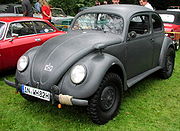
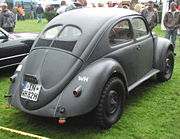 The following body types and variants of the Type 82 were produced:
The following body types and variants of the Type 82 were produced:
Type 62: Prototype Kübelwagen, constructed from May 15, 1938; pre-production models (1939) field tested in the invasion of Poland
Type 67: 2-stretcher ambulance
; Type 60 Beetle chassis with modified Type 82 body
Type 82/0: Basic four seater
Type 82/I: Three-seat radio car
Type 82/2: Sirencar (Siemens motordriven siren mounted on passenger side in place of the rear seat)
Type 82/3: Mock-up armoured vehicle/command car with machine gun-fitted turret over the cabin
Type 82/5: Kübelwagen chassis with the Type 60 LO Lieferwagen (open pickup truck) body
http://www.panzerbaer.de/models/35_cmk_vw_typ825-a.htm
Type 82/6: Tropical version sedan-body box van
Type 82/7: Three-seat 'Command car' made up of a Type 82 chassis, fitted with a Beetle body and roll-up canvas roof section. These three-seaters had a co-drivers seat with fully reclining backrest for the commander.
Type 82/8: Like Type 82/0 but had an open body made of wood
Type 82/E: Kübelwagen chassis with Beetle body (688 manufactured)
Type 86: All-wheel drive prototype (6 fabricated)
Type 87: "Kommandeurwagen" Type 86 4x4 Kübelwagen chassis with Beetle command car body. Fitted with running boards, under-hood-mounted spare tire (accompanied by a gas can, a jack, a small tool kit, and a shovel), and widened fenders for its larger-diameter Kronprinz (Crown Prince) off-road tires, some were provided to preferred officers, who could push through virtually any kind of terrain with them (667 produced) http://mitglied.lycos.de/Geschichtsverein/vwik.html
Type 89: Fitted with an experimental automatic transmission
Type 98: 4x4 Kübelwagen chassis with a Beetle body
Type 106: Fitted with an experimental transmission
(assumed different from the Type 89)
Type 107: Fitted with a turbocharger
Type 115: Fitted with a supercharger
Type 126: Fitted with a fully synchronized gearbox (assumed different from the Type 278)
Type 155/1: Half-track
/ snow-track Kübelwagen prototype. Pictures of several track-set designs exist http://web.archive.org/web/20090730170305/http://geocities.com/CapeCanaveral/Lab/1167/evwtrack.html,
although it is possible that these were consecutively fitted to the same prototype. Trials proved that the Type 155 was able to cover the most difficult terrain, but the modifications necessary to the standard Kübelwagen were extensive and the resulting vehicle was both very slow and forbiddingly inefficient.
Type 157: Railway car equipment, used for Types 82 and 87
Type 164: Six-wheeled, twin engine, dual-control prototype; never entered production
Type 177: Fitted with a five-speed transmission (as opposed to the standard four-speed unit)
Type 179: Fitted with fuel-injected Volkswagen
engine
Type 179-F: Later updated directly to the Schwimmwagen (mentioned above)- Could cross water and temporarily be used as a small boat and/or landing craft. Because of a thick and bulletproof skid plate, the engine was protected and all valves in the rear were airtight. The engine had a flush-activated 179 Fuel Injected engine that would act as a drainer to push water out and prevent the engine from flooding.
Type 198: Fitted with a PTO and auxiliary gearbox for starting the engines of armoured fighting vehicles
Type 235: Fitted for power by an electric motor
Type 239: Fitted for power by a wood-gas generator mounted on the nose (also listed as Type 230)
Type 240: Fitted for power by bottled gas
Type 276
: Type 82 fitted with a towing hook to pull a 37 PAK gun
Type 278: Fitted with synchronized gearbox
Type 307: Fitted with a heavy-duty carburetor
Type 309: Prototype fitted with a diesel engine
Type 331: Prototype fitted for power by a "native fuel system" (acetylene gas) engine (also listed as Type 231)
Type 332: Fitted for power by anthracite coal
Bucket seat
A bucket seat is a seat contoured to hold one person, distinct from bench seats which are flat platforms designed to seat multiple people. Bucket seats are standard in fast cars to keep riders in place when making sharp or quick turns...
car") was a military vehicle designed by Ferdinand Porsche
Ferdinand Porsche
Ferdinand Porsche was an Austrian automotive engineer and honorary Doctor of Engineering. He is best known for creating the first hybrid vehicle , the Volkswagen Beetle, and the Mercedes-Benz SS/SSK, as well as the first of many Porsche automobiles...
and built by Volkswagen
Volkswagen
Volkswagen is a German automobile manufacturer and is the original and biggest-selling marque of the Volkswagen Group, which now also owns the Audi, Bentley, Bugatti, Lamborghini, SEAT, and Škoda marques and the truck manufacturer Scania.Volkswagen means "people's car" in German, where it is...
during World War II
World War II
World War II, or the Second World War , was a global conflict lasting from 1939 to 1945, involving most of the world's nations—including all of the great powers—eventually forming two opposing military alliances: the Allies and the Axis...
for use by the German
Nazi Germany
Nazi Germany , also known as the Third Reich , but officially called German Reich from 1933 to 1943 and Greater German Reich from 26 June 1943 onward, is the name commonly used to refer to the state of Germany from 1933 to 1945, when it was a totalitarian dictatorship ruled by...
military (both Wehrmacht
Wehrmacht
The Wehrmacht – from , to defend and , the might/power) were the unified armed forces of Nazi Germany from 1935 to 1945. It consisted of the Heer , the Kriegsmarine and the Luftwaffe .-Origin and use of the term:...
and Waffen-SS
Waffen-SS
The Waffen-SS was a multi-ethnic and multi-national military force of the Third Reich. It constituted the armed wing of the Schutzstaffel or SS, an organ of the Nazi Party. The Waffen-SS saw action throughout World War II and grew from three regiments to over 38 divisions, and served alongside...
). Based heavily on the Volkswagen Beetle
Volkswagen Beetle
The Volkswagen Type 1, widely known as the Volkswagen Beetle or Volkswagen Bug, is an economy car produced by the German auto maker Volkswagen from 1938 until 2003...
, it was prototyped as the Type 62, but eventually became known internally as the Type 82.
With its rolling chassis and mechanics built at Stadt des KdF-Wagens
Wolfsburg
Wolfsburg is a town in Lower Saxony, Germany. It is located on the River Aller northeast of Braunschweig , and is mainly notable as the headquarters of Volkswagen AG...
, (renamed Wolfsburg after 1945), and its body built by US-owned firm Ambi Budd
Ambi Budd
Ambi Budd was a company founded by Edward Gowen Budd in Philadelphia, USA. Budd studied at the University of Pennsylvania and his first work was at a company making automobile wheels from pressed steel rather than by casting. Steel-shaping technology progressed rapidly at the time and soon the...
in Berlin http://www.ltv-vwc.org.uk/wheelspin/ws_july_2000/Wierd05_Military01.htm, the Kübelwagen was for the Germans what the jeep
Willys MB
The Willys MB US Army Jeep and the Ford GPW, were manufactured from 1941 to 1945. These small four-wheel drive utility vehicles are considered the iconic World War II Jeep, and inspired many similar light utility vehicles. Over the years, the World War II Jeep later evolved into the "CJ" civilian...
was for the Allies
Allies of World War II
The Allies of World War II were the countries that opposed the Axis powers during the Second World War . Former Axis states contributing to the Allied victory are not considered Allied states...
.
History



Adolf Hitler
Adolf Hitler was an Austrian-born German politician and the leader of the National Socialist German Workers Party , commonly referred to as the Nazi Party). He was Chancellor of Germany from 1933 to 1945, and head of state from 1934 to 1945...
discussed with Ferdinand Porsche
Ferdinand Porsche
Ferdinand Porsche was an Austrian automotive engineer and honorary Doctor of Engineering. He is best known for creating the first hybrid vehicle , the Volkswagen Beetle, and the Mercedes-Benz SS/SSK, as well as the first of many Porsche automobiles...
the possibility of military application of the Volkswagen as early as April 1934, it wasn't until January 1938, that high-ranking Third Reich army officials formally approached Porsche about designing an inexpensive, light-weight military transport vehicle that could be operated reliably both on- and off-road in even the most extreme conditions, suggesting that the Beetle could provide the basis for such a vehicle.
Porsche began work on the project immediately, having a prototype of the vehicle ready within the month, but realized during development that it wouldn't be enough to reinforce the Beetle's chassis to handle the stresses that military use would put on it. In order to guarantee adequate off-road performance of a two-wheel-drive vehicle with a 1,000 cc FMCV 1 engine, it would have to be lightweight. In fact, the army had stipulated a laden weight of 950 kg (2,094.4 lb) including four battle-dressed troops, which meant that the vehicle itself should not weigh more than 550 kg (1,212.5 lb). Porsche therefore sub-contracted Trutz, an experienced military coachbuilder to help out with the body design.
Developmental testing by the military began after a presentation of the prototypes designated as Type 62 in November 1938. Despite lacking four wheel drive
Four Wheel Drive
The Four Wheel Drive Auto Company, more often known as Four Wheel Drive or just FWD, was founded in 1909 in Clintonville, Wisconsin, as the Badger Four-Wheel Drive Auto Company by Otto Zachow and William Besserdich.-History:...
, a mainstay of the American
United States
The United States of America is a federal constitutional republic comprising fifty states and a federal district...
military Jeep
Jeep
Jeep is an automobile marque of Chrysler . The first Willys Jeeps were produced in 1941 with the first civilian models in 1945, making it the oldest off-road vehicle and sport utility vehicle brand. It inspired a number of other light utility vehicles, such as the Land Rover which is the second...
s, the vehicle proved very competent at maneuvering its way over rough terrain, even in a direct comparison with a contemporary standard German army 4x4, and the project was given the green light for further development. The vehicle's light weight and ZF self-locking differential compensated for the lack of 4X4 capabilities.
Further development of the Type 62 took place during 1939, including a more angular body design; and pre-production models were field-tested in the invasion of Poland that started in September that year. Despite their overall satisfaction with the vehicle's performance, military commanders demanded that a few important changes be made: the lowest speed of the vehicle had to be reduced from 8 km/h (5 mph) to 4 km/h (2.5 mph) as an adjustment to the pace of marching soldiers. Secondly it needed some improvement of its off road ability. Porsche responded to both requests by mounting new axles with gear-reduction hubs, providing the car with more torque and more ground-clearance all at once. Revised dampers, 41 cm (16.1 in) wheels and a limited slip differential, as well as countless small modifications completed the specification. In order to reflect the changes, the vehicle was re-named Type 82.
Full scale production of the Type 82 Kübelwagen started in February 1940, as soon as the VW factories had become operational. No major changes took place until production ended in 1945, only small modifications were implemented — mostly eliminating unnecessary parts and reinforcing some which had proved unequal to the task. Prototype versions were assembled with four-wheel-drive (Type 86) and different engines, but none offered a significant increase in performance or capability over the existing Type 82 and the designs were never implemented. As of March 1943, the car received a revised dash and the bigger 1,131 cc engine developed for the Schwimmwagen that produced more torque and power than the original 985 cc unit. When Volkswagen production ceased at the end of the war, 50,435 Kübelwagen vehicles had been produced http://mitglied.lycos.de/Geschichtsverein/vwik.html and the vehicle had proven itself to be surprisingly useful, reliable, and durable.
VW resurrected the basic Kübelwagen design several decades after the war as the 1969 Type 181
Volkswagen 181
The Volkswagen Type 181 "Kurierwagen", popularly known in the United Kingdom as the Trekker , in the United States as the Thing, and in Mexico as the Safari, was a small military vehicle produced by Volkswagen from 1969 to 1983, although civilian sales stopped in 1980...
, developed for the German Federal Armed Forces
Bundeswehr
The Bundeswehr consists of the unified armed forces of Germany and their civil administration and procurement authorities...
and later also produced for the civilian market known as "Thing" in the US, "Trekker" in the UK and "Safari" in Mexico. Although similar in looks and design, almost no parts were interchangeable with the Type 82.
Technology and performance
When the German military took delivery of the first vehicles, they immediately put them to the test on- and off-road in snow and ice to test their capability at handling European winters; several four-wheel-drive vehicles were used as reference points. The two-wheel-drive Kübelwagen surprised even those who had been a part of its development, as it handily out-performed the other vehicles in nearly every test. Most notably — thanks to its smooth, flat underbody — the Kübel would propel itself much like a motorised sled when its wheels were sinking into sand, snow or mud, allowing it to follow tracked vehicles with remarkable tenacity.In November 1943, the U.S. military conducted a series of tests as well on several Type 82s they had captured in North Africa
Africa
Africa is the world's second largest and second most populous continent, after Asia. At about 30.2 million km² including adjacent islands, it covers 6% of the Earth's total surface area and 20.4% of the total land area...
; they concluded that the vehicle was simpler, easier to manufacture and maintain, faster, and more comfortable for four passengers than the U.S. Jeeps. This statement is at odds with U.S. War Department Technical Manual TM-E 30-451, Handbook on German Military Forces, dated 15 March 1945. In this manual (p. 416), it states "The Volkswagen, the German equivalent of the U.S. "Jeep", is inferior in every way except in the comfort of its seating accommodations."

Among the design features that contributed to the Kübelwagens performance were:
- Light weight - although over 3 cm (1.2 in) longer than the Willys MBWillys MBThe Willys MB US Army Jeep and the Ford GPW, were manufactured from 1941 to 1945. These small four-wheel drive utility vehicles are considered the iconic World War II Jeep, and inspired many similar light utility vehicles. Over the years, the World War II Jeep later evolved into the "CJ" civilian...
, it was over 300 kg (661.4 lb) lighter - Very flat and smooth underbody, that allowed the car to slide over the surface it was traversing
- Considerable ground clearance - roughly 28 cm (11 in), in part thanks to:
- The use of portal gearPortal gearPortal axles are an offroad technology where the axle tube is above the center of the wheel hub.-Description:Compared to normal layout, portal axles enables the vehicle to gain a higher ground clearance, as both the axle tube and differential casing are tucked up higher under the vehicle.Due to...
hub reduction, providing more torque and ride height simultaneously - Independent suspension on all four wheels
- Self-locking differential, limiting slippage and retaining traction.
- The use of portal gear
Apart from that the air-cooled engine proved highly tolerant of hot and cold climates, and less vulnerable to bullets due to the absence of a radiator. For starting under winter conditions, a specially volatile starting fuel was required, contained in a small auxiliary fuel tank.
As the body was not a load-bearing part of the structure of the vehicle, it could easily be modified to special purposes.
The Kübelwagen could reach a top speed of 80 km/h (49.7 mph).
Body variants


Type 62: Prototype Kübelwagen, constructed from May 15, 1938; pre-production models (1939) field tested in the invasion of Poland
Type 67: 2-stretcher ambulance
Ambulance
An ambulance is a vehicle for transportation of sick or injured people to, from or between places of treatment for an illness or injury, and in some instances will also provide out of hospital medical care to the patient...
; Type 60 Beetle chassis with modified Type 82 body
Type 82/0: Basic four seater
Type 82/I: Three-seat radio car
Type 82/2: Sirencar (Siemens motordriven siren mounted on passenger side in place of the rear seat)
Type 82/3: Mock-up armoured vehicle/command car with machine gun-fitted turret over the cabin
Type 82/5: Kübelwagen chassis with the Type 60 LO Lieferwagen (open pickup truck) body
http://www.panzerbaer.de/models/35_cmk_vw_typ825-a.htm
Type 82/6: Tropical version sedan-body box van
Type 82/7: Three-seat 'Command car' made up of a Type 82 chassis, fitted with a Beetle body and roll-up canvas roof section. These three-seaters had a co-drivers seat with fully reclining backrest for the commander.
Type 82/8: Like Type 82/0 but had an open body made of wood
Type 82/E: Kübelwagen chassis with Beetle body (688 manufactured)
Type 86: All-wheel drive prototype (6 fabricated)
Type 87: "Kommandeurwagen" Type 86 4x4 Kübelwagen chassis with Beetle command car body. Fitted with running boards, under-hood-mounted spare tire (accompanied by a gas can, a jack, a small tool kit, and a shovel), and widened fenders for its larger-diameter Kronprinz (Crown Prince) off-road tires, some were provided to preferred officers, who could push through virtually any kind of terrain with them (667 produced) http://mitglied.lycos.de/Geschichtsverein/vwik.html
Type 89: Fitted with an experimental automatic transmission
Automatic transmission
An automatic transmission is one type of motor vehicle transmission that can automatically change gear ratios as the vehicle moves, freeing the driver from having to shift gears manually...
Type 98: 4x4 Kübelwagen chassis with a Beetle body
Type 106: Fitted with an experimental transmission
Transmission (mechanics)
A machine consists of a power source and a power transmission system, which provides controlled application of the power. Merriam-Webster defines transmission as: an assembly of parts including the speed-changing gears and the propeller shaft by which the power is transmitted from an engine to a...
(assumed different from the Type 89)
Type 107: Fitted with a turbocharger
Turbocharger
A turbocharger, or turbo , from the Greek "τύρβη" is a centrifugal compressor powered by a turbine that is driven by an engine's exhaust gases. Its benefit lies with the compressor increasing the mass of air entering the engine , thereby resulting in greater performance...
Type 115: Fitted with a supercharger
Supercharger
A supercharger is an air compressor used for forced induction of an internal combustion engine.The greater mass flow-rate provides more oxygen to support combustion than would be available in a naturally aspirated engine, which allows more fuel to be burned and more work to be done per cycle,...
Type 126: Fitted with a fully synchronized gearbox (assumed different from the Type 278)
Type 155/1: Half-track
Half-track
A half-track is a civilian or military vehicle with regular wheels on the front for steering, and caterpillar tracks on the back to propel the vehicle and carry most of the load. The purpose of this combination is to produce a vehicle with the cross-country capabilities of a tank and the handling...
/ snow-track Kübelwagen prototype. Pictures of several track-set designs exist http://web.archive.org/web/20090730170305/http://geocities.com/CapeCanaveral/Lab/1167/evwtrack.html,
although it is possible that these were consecutively fitted to the same prototype. Trials proved that the Type 155 was able to cover the most difficult terrain, but the modifications necessary to the standard Kübelwagen were extensive and the resulting vehicle was both very slow and forbiddingly inefficient.
Type 157: Railway car equipment, used for Types 82 and 87
Type 164: Six-wheeled, twin engine, dual-control prototype; never entered production
Type 177: Fitted with a five-speed transmission (as opposed to the standard four-speed unit)
Type 179: Fitted with fuel-injected Volkswagen
Volkswagen
Volkswagen is a German automobile manufacturer and is the original and biggest-selling marque of the Volkswagen Group, which now also owns the Audi, Bentley, Bugatti, Lamborghini, SEAT, and Škoda marques and the truck manufacturer Scania.Volkswagen means "people's car" in German, where it is...
engine
Type 179-F: Later updated directly to the Schwimmwagen (mentioned above)- Could cross water and temporarily be used as a small boat and/or landing craft. Because of a thick and bulletproof skid plate, the engine was protected and all valves in the rear were airtight. The engine had a flush-activated 179 Fuel Injected engine that would act as a drainer to push water out and prevent the engine from flooding.
Type 198: Fitted with a PTO and auxiliary gearbox for starting the engines of armoured fighting vehicles
Type 235: Fitted for power by an electric motor
Type 239: Fitted for power by a wood-gas generator mounted on the nose (also listed as Type 230)
Type 240: Fitted for power by bottled gas
Type 276
VW 276 Schlepperfahrzeug
The Volkswagen Type 276 Schlepperfahrzeug was a derivative of the Kübelwagen Type 82 which was modified to enable it to tow a load, gun or a trailer, that would be deployed in a unit which comprised two modified Kübelwagen, a small caliber anti-tank gun , an ammunition trailer laden with 16 cases...
: Type 82 fitted with a towing hook to pull a 37 PAK gun
Type 278: Fitted with synchronized gearbox
Type 307: Fitted with a heavy-duty carburetor
Carburetor
A carburetor , carburettor, or carburetter is a device that blends air and fuel for an internal combustion engine. It is sometimes shortened to carb in North America and the United Kingdom....
Type 309: Prototype fitted with a diesel engine
Diesel engine
A diesel engine is an internal combustion engine that uses the heat of compression to initiate ignition to burn the fuel, which is injected into the combustion chamber...
Type 331: Prototype fitted for power by a "native fuel system" (acetylene gas) engine (also listed as Type 231)
Type 332: Fitted for power by anthracite coal
Coal
Coal is a combustible black or brownish-black sedimentary rock usually occurring in rock strata in layers or veins called coal beds or coal seams. The harder forms, such as anthracite coal, can be regarded as metamorphic rock because of later exposure to elevated temperature and pressure...
External links
See also
- FN Herstal AS 24
- FMC XR311FMC XR311The XR311 was a prototype military vehicle of US origin, given the nickname G.I. Hotrod.-Development:Development of the XR311 commenced as a private venture in 1969 with the first of two prototypes being completed in 1970. As a result of the trials of these 2 prototypes the US Army purchased 10...
- M151 MUTT
- Baja bugBaja BugThe term Baja Bug generally refers to an original Volkswagen Beetle modified to operate off-road , although other versions of air-cooled Volkswagens are sometimes modified as well.-History:...
- Cal LookCal LookA Cal looker is any aircooled Volkswagen that has been modified in a style that originated in California in the late 1960s.- Common modifications:...
- Punch buggyPunch buggyPunch buggy is a car game generally played by children in which participants punch each other in the arm upon first sight of a Volkswagen Beetle while calling out "Slug bug!" or "Punch buggy!" in reference to the Beetle's nickname, the Bug.- History :Most references about the game originate from...
- Steyr 50Steyr 50The Steyr 50 is a small car released in 1936 by the Austrian automobile manufacturer Steyr. The streamlined body was approved by Director Karl Jenschke to be constructed in 1935, but in that same year Jenschke relocated to the German Adlerwerke in Frankfurt/Main.The car had a water-cooled...
- Volksrod
- VolkswagenVolkswagenVolkswagen is a German automobile manufacturer and is the original and biggest-selling marque of the Volkswagen Group, which now also owns the Audi, Bentley, Bugatti, Lamborghini, SEAT, and Škoda marques and the truck manufacturer Scania.Volkswagen means "people's car" in German, where it is...
- Volkswagen 181Volkswagen 181The Volkswagen Type 181 "Kurierwagen", popularly known in the United Kingdom as the Trekker , in the United States as the Thing, and in Mexico as the Safari, was a small military vehicle produced by Volkswagen from 1969 to 1983, although civilian sales stopped in 1980...
(Thing/Safari/Trekker) - Volkswagen BeetleVolkswagen BeetleThe Volkswagen Type 1, widely known as the Volkswagen Beetle or Volkswagen Bug, is an economy car produced by the German auto maker Volkswagen from 1938 until 2003...
- Volkswagen New BeetleVolkswagen New Beetle-Specifications:*Dimension:**Length: **Width: **Height: **Wheelbase: **Curb weight: *Max speed: 177–210 km/h *Acceleration : 6.5-13.2 sec-Body styles:-Engine choices:-Safety:...

